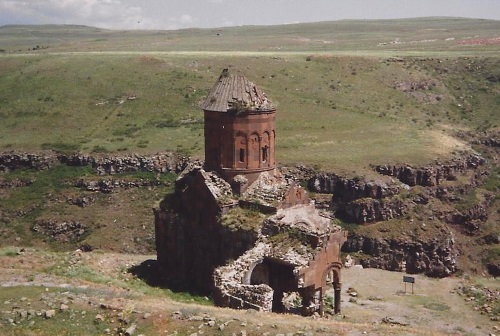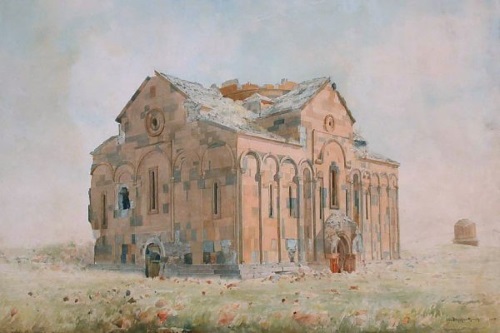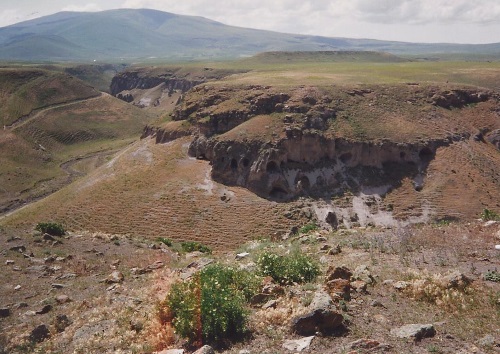Turkey has nominated
Ani Cultural Landscape as one of its two candidates for the 2016 WHC session, which it will host in Istanbul next July. Ani comprises the ruins of a medieval Armenian city. It lies in the far east of Turkey, right at the border with Armenia. Between 961 and 1045, it was the capital of the
Bagratid Armenian kingdom that covered much of present-day Armenia and eastern Turkey.
 |
| The church of St Gregory of Tigran Honents in Ani, in the year 1992 |
Considering the history between Turkey and Armenia, this is a controversial nomination. I won’t go into detail here about the current Turkish political scene and its complicated opinions on what happened in 1915 (you can have a look at Erdogan’s shifting points of view
here). But behind the scenes the acceptance of Ani as an important part of the heritage of this region has been in the making for almost 20 years. The site finally entered Turkey’s Tentative List in 2012.
In their study
US Cultural Diplomacy and Archaeology: Soft Power, Hard Heritage, Christina Luke and Morag M. Kersel argue that the placement of Ani on the
Watch List of the World Monuments Fund in 1996 was the most important trigger in the conservation and recognition of Ani. The US government supported this, as the normalization of Turkey’s relation with Armenia would sustain Turkey’s important bridge function. They conclude: “the support for preservation of Ani with U.S. congressional funds (as part of a much larger initiative with the World Monuments Fund and others) is yet another example of the strategic and political use of archaeological heritage by the U.S. Department of State”.
 |
| Ani Cathedral, in the eyes of Armenian painter Arshak Fetvadjian (1905) |
I visited Ani way back in 1992, during a 3-week-long group tour that took us all over Turkey by bus. I don’t remember much about Ani, only the remoteness (and excoticness!) of whole eastern Turkey is a clear memory. Ani itself for me is symbolized by that one ruined church (see first photo) and the deep gorge next to it that divides the two countries.
Since then quite a lot seems to have changed. While looking for additional photos to accompany this post I noticed all kinds of buildings that I do not remember from 1992, some including interior murals. The website
Virtual Ani covers all of them. Recent visitors confirm that it stil is an off-the-beaten-track destination though.
Minor Sights describes his visit from 2012 as a lonely experience and helpfully suggests "Don't mention the war!" A
Tripadvisor report from June 2015 hints at the very vast size of the site, the need to bring plenty of drinking water and the entrance fee of 8 Turkish Lira.
Turkey’s WH history and current approach has been summarized nicely
here on our Forum. Activity has strongly increased since 2011. This corresponds with the observations of US Architectural Historian Heghnar Watenpaugh in
Preserving the Medieval City of Ani: Cultural Heritage between Contest and Reconciliation: “These high-profile government initiatives occur at a time of unprecedented deliberation within Turkish civil society about the country’s foundation and modern history, often articulated through cultural heritage.” And “… the public debate about non-Muslims in the late Ottoman Empire has positioned Ani at the center of dialogue about the ambiguities of preservation and the politics of cultural memory in contemporary Turkey.”
Watenpaugh sees heritage as a medium “for reconciliation rather than only contestation”. She worries that Turkey only brings Ani forward to attract international tourists: “The fact that culture and tourism share the same ministry in Turkey has prompted criticism that the tourism industry’s pursuit of profit might be the driving force in cultural management decisions”.
 |
| The gorge dividing Turkey and Armenia (also 1992). |
| Some rock-cut dwellings can be seen too, which are part of the WH nomination. |
The question remains: will Ani become a WHS in 2016? Googling for how the nomination will be presented by Turkey, I stumbled upon the
Executive Summary of the Nomination Dossier. As a proposed Cultural Landscape, it relies heavily on the “interchange of ideas”. Quotes such as “stylistic interactions between Christian and Islamic art” and “center of a multi-national and multi religious population” attribute to this.
Watenpaugh already foresaw this approach in her December 2014 article: “The rhetoric official Turkish state organizations use when they refer to Ani often invokes the trope of multiculturalism to describe this multilayered site. It is undoubtedly appropriate to discuss Ani in terms of a crossroads of cultures. However, sometimes multiculturalist rhetoric is used to gloss over, erase, or silence Ani’s most crucial layers.”
In the Executive Summary the term ‘Armenian’ appears 6 times. The fact that we’re mainly talking about Armenian churches here is not denied. It would not surprise me that the WMF has assisted the Turkish Ministry of Culture in writing the nomination and make it acceptable to a broader audience. It also underlines Watenpaugh’s observation of “the introduction of limited acknowledgment at the state level regarding Turkey’s minorities such as the Armenians, Alevis, and Kurds”.
I am interested in what ICOMOS has to say about the way restorations have been done by Turkish and international conservationists. In a
reply to my question, Virtual Ani-owner Steven Sim (who has visited Ani yearly since 1984) wrote: “… thanks to the destruction of Ani's integrity as a historical site (caused by recent extensive and heavy-handed restoration works and rebuilding), I doubt that Ani can genuinely now meet the standards required to be listed as a World Heritage Site. If it were to be listed, it would just be additional proof that UNESCO is all about politics.”
It seems that the planned site visit by ICOMOS has already been cancelled because of the current internal unrest within Turkey. Given the fact though that Turkey will be the host of the 2016 WHC session, I cannot see the nomination being referred or deferred (combined with the disdain the recent sessions have shown to ICOMOS’s opinion anyway). Probably some compromise will be found, maybe they will put Ani on the
In Danger List simultaneously?
Worth mentionning that Armenia TL has "the basilica ans archeological site of Yererouk", which lies 5 kilometers across the border with Trukey and Ani cultural landscape.
It would make a good (but very unlikely) transnational nomination.
Thanks for mentioning our piece about Ani.
It's great that Ani is a candidate for the WHC session. The site needs all the attention it can get and it is far from being at risk of being overrun by tourist- quite the opposite.
In spite of the complex and sensitive history, I'm positive that Turkey has been moving in the right direction with its recognition of Ani and other Armenian heritage as part of its own heritage.
We recently published a follow-up piece about some of the Armenian churches near Ani. You might want to read it too.
The address is www.minorsights.com/2015/10/turkey-minor-armenian-churches.html
Thanks, Els, for this comprehensive overview about Ani and the politics / considerations around it!


